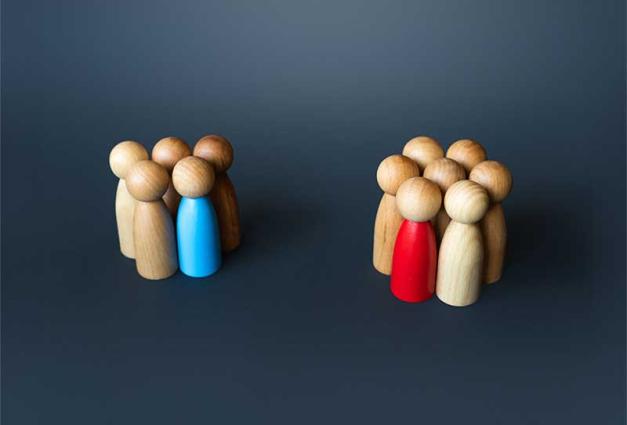Smiles and laughter are some of the most frequent behaviors in everyday life. In a 2008 study by researchers at the University of Liverpool, strangers having a conversation laughed more than once every two minutes and smiled several times per minute. We smile when we're thrilled, flirting, embarrassed, confused, acknowledging a stranger, winning, or losing. We laugh when we're amused, nervous, angry, greeting a puppy, teasing, or don't know what to say.
My colleagues and I are working to understand how these evolutionarily ancient behaviors convey so many different messages.
Smiles and laughter usually happen in the presence of other people. They are meant to be seen, to be heard. And they are meant to influence the people who see and hear them. My colleagues and I think that smiles and laughs serve at least three (sometimes overlapping) functions: they can reward, convey affiliative intentions, or assert dominance.
First, reward. These are the quintessential feel-good smiles and laughs. They not only reflect the expresser's positive state, but they also reward the other person for causing that positive state. It feels good when people smile and laugh with us this way, especially when we know we caused it. Marketing firms put smiling faces on ads for everything from car insurance to toilet paper because they want consumers to feel good when thinking about their products. Similarly, the laugh tracks that accompany sitcoms take advantage of the feel-good effect of laughter.
We believe these rewarding smiles and laughs originated as mammalian play signals. Play signals make it clear that the animals mean no harm. In a way, smiles and laughter serve the same function. And because the signals are rewarding—they make the recipient feel good—they also help prolong the playful interaction.
However, most smiles and laughter are not rewarding outpourings of positivity. Think of the quick, closed-lip face you make to acknowledge a passing stranger or convey sympathy to a friend. Or the polite chuckle you use to ease awkward tension in a work meeting. They are shadows of those big, feel-good smiles and laughs. What they borrow from reward signals is the message of friendly, harmless intentions, which is why we call these smiles and laughs "affiliation signals." Smiles and laughter that emanate from nervousness, embarrassment, sexual attraction, friendliness, and politeness have the shared underlying goal of increasing affiliation.
What about smiles and laughter that, far from making the recipient feel good, actually make them feel bad? You know the feeling when you're being laughed at rather than laughed with. Sometimes people smile and laugh while teasing, mocking, deriding, and criticizing. We call these behaviors "dominance" smiles and laughter, because they convey superiority. At first glance, it is paradoxical to think that a play signal that conveys harmless intentions could be twisted into a not-so-harmless message. But what people are saying when they smile and laugh this way is, "I find you utterly harmless and unserious." There's arguably no better way to convey your dominance over someone than to convey that you don't take them seriously.
The effect of smiles, and laughter, depends partly on the context and who is doing the smiling and laughing. When a rival smiles at you, it may always feel threatening. But our work suggests that the effect of smiles and laughter on the observer is partly due to the physical form: how symmetric or open-mouthed the smile is, how melodious or nasal the laughter is.
My colleagues and I have taken many approaches to studying the social functions of smiles and laughter. In one study, Dr. Jared Martin had people give stressful speeches while an observer smiled at them in rewarding, affiliative, or dominant ways. He found that the stress-related hormone cortisol was highest when their speeches were met with dominance smiles, and lowest when met with reward smiles. It seems smiles are not always received positively. Sometimes they are stressful.
Our most recent work brought smiles and laughter together. We showed over a thousand online participants brief videos of rewarding, affiliative, or dominant smiles produced by actors. The observers then listened to two brief laughter recordings, also produced by actors, and chose the recording that they thought was most similar to the smile in its underlying message. We found they tended to put reward smiles with reward laughs and affiliation smiles with affiliation laughs, but they did not tend to put dominance smiles with dominance laughs. It seems that the mapping between the meaning of smiles and laughter isn't as straightforward as we originally assumed.
We need to do more to understand if smiles and laughter can send the same messages. Can you replace a polite smile with a polite laugh when you're on the phone and the recipient can't see you? Can you tease just as effectively with a smile as with a laugh?
For now, what we do know is that smiles and laughter are versatile behaviors that help us change the emotions, thoughts, and behaviors of the people around us. And that's something to smile about.
For Further Reading
Dunbar, R., & Mehu, M. (2008). Naturalistic observations of smiling and laughter in human group interactions. Behaviour, 145(12), 1747-1780. https://doi.org/10.1163/156853908786279619
Wood, A., & Niedenthal, P. (2018). Developing a social functional account of laughter. Social and Personality Psychology Compass, 12(4), e12383. https://doi.org/10.1007/s42761-020-00022-w
Wood, A., Sievert, S., & Martin, J. (2022). Semantic similarity of social functional smiles and laughter. Journal of Nonverbal Behavior. https://doi.org/10.1007/s10919-022-00405-6
Adrienne Wood is an Assistant Professor of Psychology at the University of Virginia. She studies how people communicate and connect.




